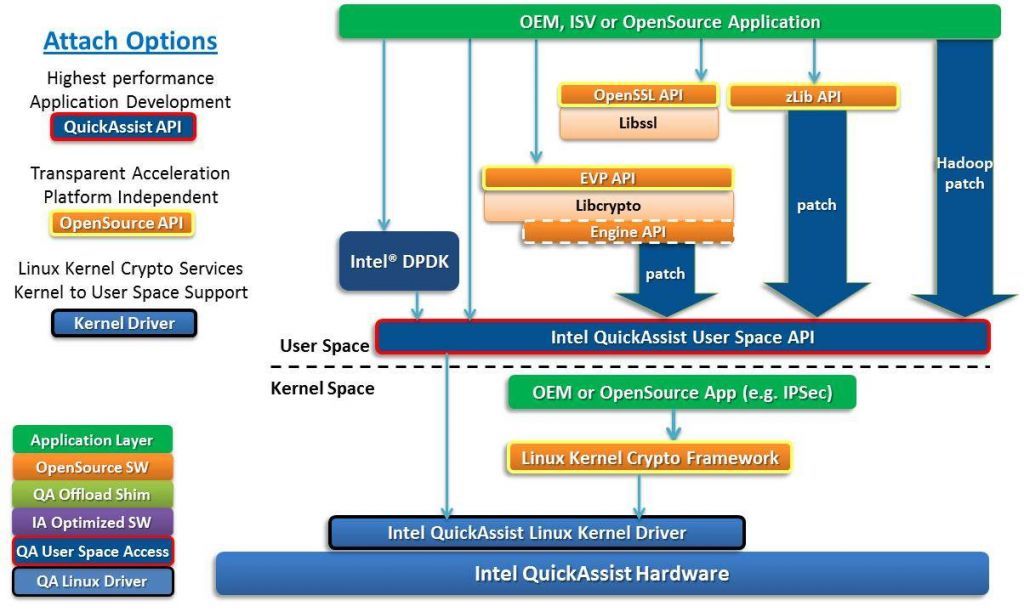Intel QuickAssist: let's encrypt it quickly
In our troubled world, concern about our own information security has long ceased to be viewed as a form of paranoia, and application developers have to be considered with this - all other things being equal, the user will choose the one that better protects his data. To make it easier for programmers to live, Intel has developed QuickAssist (QAT) encryption and compression acceleration technology as part of its open source program. Let's take a closer look at it.

So, as already mentioned, QAT can be useful for the following tasks:
Intel QuickAssist is a combined hardware and software solution. From a software point of view, QuickAssist is a set of APIs that implement encryption and compression algorithms on a specific specific hardware. For some popular open source products, such as zLib, NGINX, Hadoop, there are patches that allow you to use QuickAssist without understanding its internal structure at all. The software can be any OS in the Linux family.
')

Now about the gland. For QuickAssist to function, the server must have one of the following hardware components:
It must be admitted that neither one nor the other hardware component can be called widespread - in order to try QuickAssist in practice, you will have to be thoroughly confused when searching for a suitable server.

Appearance of Intel QuickAssist Adapter
Naturally, the question arises: how much does the use of QuickAssist increase application performance? The test results are impressive. So, the work of Hadoop in conjunction with QuickAssist is accelerated by 30%. Using QuickAssist with OpenSSL increases the number of connections per second 6 times! Definitely, in some cases, QuickAssist can help a lot. By the way, a small hint for those interested: although the Intel website is silent about this, QAT support is also available in the Intel Atom C2000 processor line .
Finally, here is a short list of links for studying QAT:

So, as already mentioned, QAT can be useful for the following tasks:
- encryption of data streams: symmetric encryption and authentication, operations with cipher;
- public key cryptography: asymmetric encryption, digital signatures, key exchange;
- compression: lossless data compression on the fly and static objects.
Intel QuickAssist is a combined hardware and software solution. From a software point of view, QuickAssist is a set of APIs that implement encryption and compression algorithms on a specific specific hardware. For some popular open source products, such as zLib, NGINX, Hadoop, there are patches that allow you to use QuickAssist without understanding its internal structure at all. The software can be any OS in the Linux family.
')

Now about the gland. For QuickAssist to function, the server must have one of the following hardware components:
- or a specialized QuickAssist adapter (Intel QuickAssist Adapter), currently there are two varieties, 8920 and 8950
- either a motherboard with 8920 or 8950 chipsets and Intel Xeon processors
It must be admitted that neither one nor the other hardware component can be called widespread - in order to try QuickAssist in practice, you will have to be thoroughly confused when searching for a suitable server.

Appearance of Intel QuickAssist Adapter
Naturally, the question arises: how much does the use of QuickAssist increase application performance? The test results are impressive. So, the work of Hadoop in conjunction with QuickAssist is accelerated by 30%. Using QuickAssist with OpenSSL increases the number of connections per second 6 times! Definitely, in some cases, QuickAssist can help a lot. By the way, a small hint for those interested: although the Intel website is silent about this, QAT support is also available in the Intel Atom C2000 processor line .
Finally, here is a short list of links for studying QAT:
- Archive with QAT driver
- Release notes
- Training video
(links to other lessons on this page) - Intel's QuickAssist page
Source: https://habr.com/ru/post/320380/
All Articles